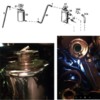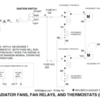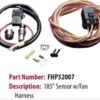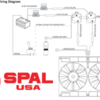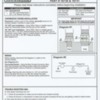Hi all:
I’m still in the silly questions phase as I try to figure out/debug #2814. I appreciate any help the group can offer.
I ran the car a dozen times this summer with no cooling issues, but it has overheated (maxxed at 230 degrees on the gauge) and spewed coolant on my driveway the last three drives. On the last one of these occasions steam was coming out of the top of the swirl tank for the last 5 minutes of a 20 minute local drive, with outside temp around 60 degrees. Each time this happened there was a very noticeable boiling sound coming from the swirl tank area.
I may have a fan/electrical problem of some sort as I haven't seen the "fan" light come on for at least the last couple of drives, and on the last drive I checked the fans on my Fluidyne when I got home and they weren’t spinning. I did make a change to the car late this summer, upgrading the alternator from 40 amps to 70 in an attempt to improve a charging/hot start issue. Could that have affected the fan operation? I definitely had at least a couple of trouble-free runs after that.
Here’s the note from my mechanic’s invoice, advising me to run a new cable directly from the battery to the fans (haven’t done this yet—is it a good idea??).
“Diagnose charging system issue - charging is adequate when cold but gauge reads not charging when warm; Test battery, starting, and charging system with diagnostic tool - Battery output is "low", starting system load is acceptable, and charging system is "low output"; Remove and replace alternator with higher output variant (70A), compromised voltage regulator, and battery; Test - charging system output is improved when warm, however radiator fans are determined to place too large
of a load on factory charging system and wiring. Factory wiring cannot handle a higher-output alternator. Only solution is to install heavy-gauge wiring directly from fans to battery and a higher output alternator.”
I’m am planning to install Jon Haas’s Pantera Electronics fusebox—is there a chance that might have a positive impact on this issue?
In the meantime, I thought I’d refill the coolant and get the air out of the system per the instructions on this forum. I filled the swirl tank to the top, and opened the radiator petcock to vent air, but did not add any coolant to the overflow tank, which was about 1/3 full. As I did this, I noticed my system doesn't look quite like either the stock or modified diagrams on the "sticky", but it does look like the standard parts diagram on Wilkinson’s site. The big difference from the “OEM” diagram on the sticky is that the upper tube from the overflow tank just empties out under the car. Is that correct? How does the system stay pressurized with an open hose coming out of it?
I’m also wondering about the pressure cap on my swirl tank, as I noticed a section of the “sticky” on that topic. When I brought the car in to my mechanic right after it arrived here, it spewed coolant on the floor of his shop. Their assessment of the problem was that I had an improper European pressure cap and they replaced it with a standard 16 psi one. That seemed to work fine for most of the summer but I wonder if it’s now part of the problem. Can someone tell by the photo if I have a European or US neck?
Thanks for any thoughts on these issues.
Tim
Attachments
Original Post


